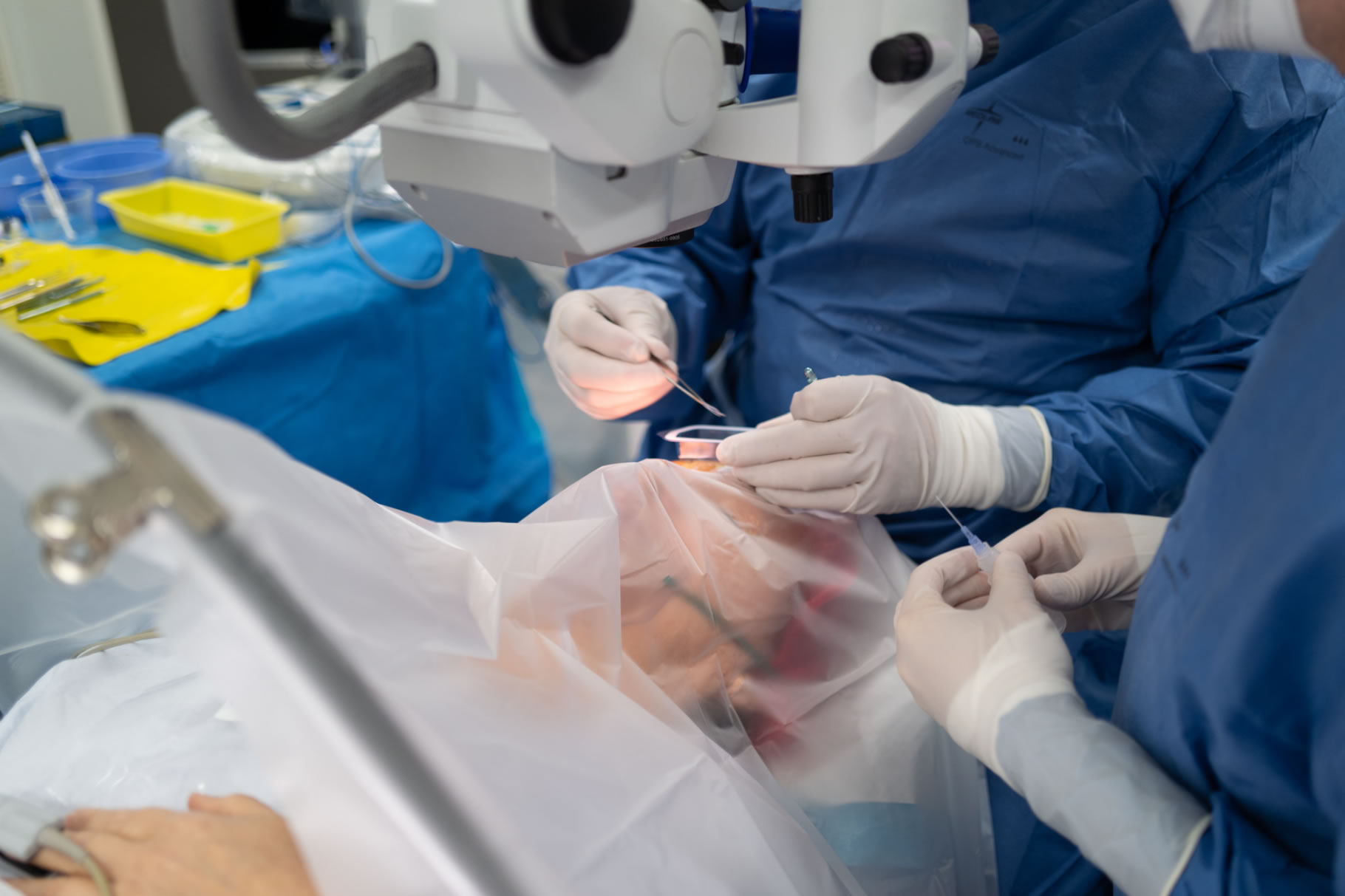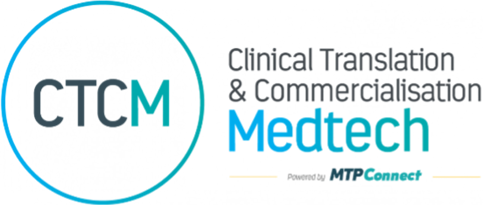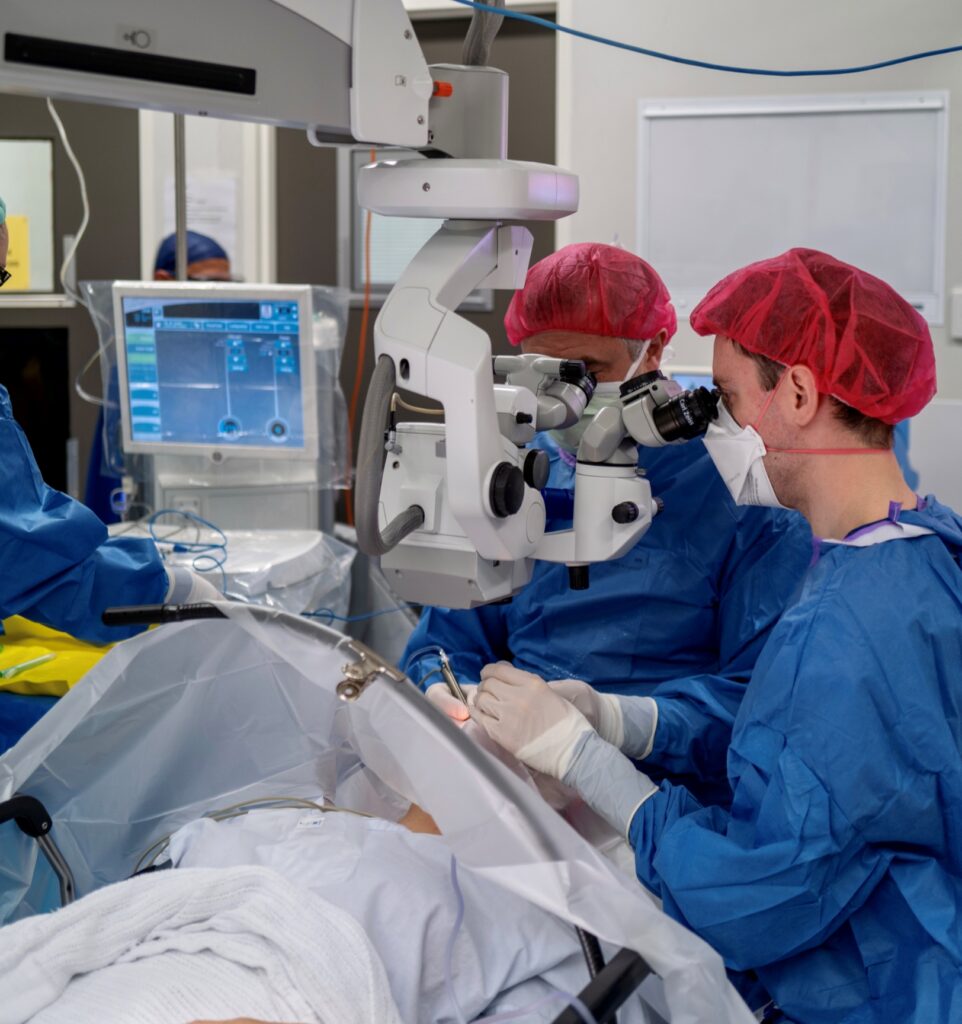Clinical stage, ophthalmology company designing, engineering, and manufacturing novel technologies.
Developing a microfluidic implant to manage glaucoma.
A world first diagnostic system to assess eye tissue functionality.
About Us
Company
VividWhite is a private Australian, clinical stage, medical device company designing, engineering, and manufacturing novel products to treat ophthalmic conditions.
VividWhite’s lead medical device, currently in human clinical trials, is a microfluidic surgical implant that carries fluid from the front of the eye, to disperse in the surrounding tissue – intended to relieve intra-ocular pressure and treat glaucoma. As part of the company’s portfolio, VividWhite is developing a world first diagnostic system to clinically and intra-operatively assess eye tissue functionality.

History
2010-17: Idea / Research
Computational modeling of fluid flow and IOP, animal research, design and develop VW-1 and VW-2 prototypes.
2017: VividWhite
Company formation, private investment, design and develop VW-3 then VW-4 devices. Preclinical assessment of VW-4.
2021-22: Manufacturing
Nanofabrication techniques finalised to create VW-5 series, clinical grade devices ready for human use. Patent filing.
Aug 2022-23: Feasibility Study
Human clinical study in 10 participants to assess device safety and performance.
Dec 2023-25: Pivotal Study
Larger scale 65 participant multi-centre clinical study for device registration.
Our People

Andrew Batty
Chief Executive Officer
BSc MCom
Experienced MedTech CEO and has established, managed and raised capital for private and ASX listed companies, developing and commercialising novel medical devices and biotech for international markets.

A/Prof Michael Coote
Chief Medical Officer
MBBS FRANZCO GAICD
Experienced MedTech CEO and has established, managed and raised capital for private and ASX listed companies, developing and commercialising novel medical devices and biotech for international markets.

Christopher Smith
Chief Technology Officer
BSc MEng
Biomedical Engineer experienced working with start-ups, SMEs and universities to design and develop medical devices, project managed several device development programs through to pre-clinical and human trials.

Dr. Craig Ross
Chief Scientific Officer
MBBS
Medical practitioner and ophthalmology researcher, with experience managing in-vivo laboratory studies and human clinical studies with a Clinical Research Organisation (CRO).

Christopher Ong
Biomedical Engineer
BSc MEng
Biomedical Engineer with skills in microfluidic technologies, product design and project management. Experienced working in a startup environment and has participated in university and SME accelerator programs.
Our Partners
VividWhite brings together world leaders in ophthalmology, microfluidics, advanced manufacturing, and medical device commercialisation.
‘VividWhite has recruited some serious talent’








Products
VividFlo Glaucoma Implant (VW-51)
VividFlo is a micro-sized, leaf shaped, medical device currently undergoing clinical trials. It contains an internal network of channels to drain fluid out of the eye to relieve intra-ocular pressure, treat glaucoma, and prevent permanent vision loss.
VividFlo is surgically implanted under the eyelid and allows fluid to travel from the front of the eye through tiny fluid channels (about half the thickness of a human hair) before gently perfusing from 150+ exit channels into the surrounding tissues. The device’s novel and patented features prevent leakage and hypotony (deflation of the eye).
The device may improve the long-term performance of glaucoma drainage devices, by maintaining high levels of tissue permeability.

VividLab Diagnostic Equipment (VW-71)
“…we need to know about outflow resistance and rate of structural and functional change…”
VividLab is a surgical instrument in the early stages of development – to be used during ophthalmic surgery to characterise the condition of the ocular tissue in patients with an elevated IOP and/or glaucoma, as a diagnostic aid. VividLab is also used to stabilise the intraocular pressure at safe levels (and prevent hypotony) in patients undergoing intraocular surgery.
This device may assist ophthalmic surgeons to understand the drainage capacity and permeability of the eye’s trabecular network to predict the outflow functionality or the tissue’s Effective Ocular Porosity (EOP).


Glaucoma
Glaucoma is a condition of increased pressure within the eyeball, causing gradual loss of sight.
Glaucoma is the most common cause of preventable blindness and affects more than 300,000 Australians1 and 60.5 million people worldwide2, with the World Health Organisation estimating that 4.5 million people are living with blindness as a result of glaucoma3.
~80 Mil
People worldwide are living with glaucoma
$7Bil
Each year spent on pharma therapeutics globally to treat glaucoma
~$2 Bil
Global surgical devices market
Some problems are so complex that you have to be highly intelligent and well
informed just to be undecided about them.
Laurence J Peter
Glaucoma Explained
As glaucoma is a progressive disease, it requires ongoing treatment and management to delay its progression.
Existing management strategies for glaucoma rely on a reduction in the intra-ocular pressure (IOP) of the eye – “the only treatable risk factor that has been identified to delay progression of glaucoma”4.
Glaucoma surgery is the most effective means for lowering intraocular pressure by providing a new route for fluid to exit the eye. This new pathway is through the sclera of the eye into sub-conjunctival tissue, where a fluid filled bleb typically forms under the conjunctiva. The long-term success of the procedure relies on the capacity of the sub-conjunctival tissue to absorb the excess fluid presented to it, without generating excessive scar tissue during tissue remodeling that will shut-down fluid flow. 1
Normal Vision

Early Glaucoma

Advanced Glaucoma

Severe Glaucoma

Resources
News

VividWhite Awarded $1 million CTCM
Funding to Develop New Implant for
Glaucoma Patients
Vivid White is pleased to announce that it has been awarded $1 million in funding from the Clinical Translation and Commercialisation Medtech (CTCM) program to progress its novel micro-fluidics ocular surgical implant. The CTCM funding and support, a Medical Research Future Fund initiative delivered by MTPConnect, will facilitate the next stage of manufacturing scale up and a new multi-centre clinical study to start end of 2023.

Contact
Need more information? Provide us with
your details and we will contact you as
soon as possible. Alternatively, send us
an email at contact@vividwhite.com.au
Publications
1) Gardiner BS, Smith DW, Coote M, Crowston JG. Computational modeling of fluid flow and intra-ocular pressure following glaucoma surgery. PLoS One. 2010 Oct 4;5(10):e13178. doi: 10.1371/journal.pone.0013178. PMID: 20957178; PMCID: PMC2949396. https://pubmed.ncbi.nlm.nih.gov/20957178/
2) Nguyen DQ, Ross CM, Li YQ, Pandav S, Gardiner B, Smith D, How AC, Crowston JG, Coote MA. A model to measure fluid outflow in rabbit capsules post glaucoma implant surgery. Invest Ophthalmol Vis Sci. 2012 Oct 5;53(11):6914-9. doi: 10.1167/iovs.12-10438. PMID: 22956615. https://pubmed.ncbi.nlm.nih.gov/22956615/
3) Coote M. Stenting eyes: the pressure to perform. Clin Exp Ophthalmol. 2013 Sep-Oct;41(7):631-2. doi: 10.1111/ceo.12177. PMID: 24090411. https://pubmed.ncbi.nlm.nih.gov/24090411/
4) Ross C, Pandav SS, Li YQ, Nguyen DQ, Beirne S, Wallace GG, Shaarawy T, Crowston JG, Coote M. Determination of bleb capsule porosity with an experimental glaucoma drainage device and measurement system. JAMA Ophthalmol. 2015 May;133(5):549-54. doi: 10.1001/jamaophthalmol.2015.30. PMID: 25719729. https://pubmed.ncbi.nlm.nih.gov/25719729/
5) Pandav SS, Ross CM, Thattaruthody F, Nada R, Singh N, Gautam N, Beirne S, Wallace GG, Sherwood MB, Crowston JG, Coote M. Porosity of Bleb Capsule declines rapidly with Fluid Challenge. J Curr Glaucoma Pract. 2016 Sep-Dec;10(3):91-96. doi: 10.5005/jp-journals-10008-1208. Epub 2016 Oct 29. PMID: 27857488; PMCID: PMC5104968. https://pubmed.ncbi.nlm.nih.gov/27857488/
6) Coote M. Blebs, Barriers, and Bagpipes: Why is it so Hard? J Curr Glaucoma Pract 2016; 10(3):79-84. https://pubmed.ncbi.nlm.nih.gov/27857486/